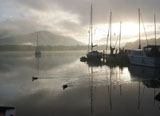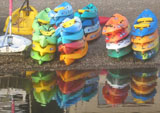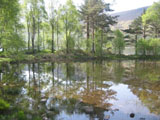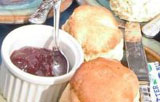|
|
Lake District Valley and
Low-level Walks
Easy walks around Coniston
Click here for more walks around Coniston
Levers Water, Coniston
Levers Water stands in a natural cove, on the side of the Old Man of
Coniston. Once a natural tarn, it was dammed and enlarged to provide
power for the mining operations in Coppermines Valley. This route
ascends alongside the Levers Waterfall, circuits the tarn and comes down
via Boulder Valley and Church Beck. Although hard going in places, you are
rewarded with wonderful views of Coniston and a chance to explore a
landscape rich in industrial heritage.
Distance and terrain: 7.5km (4.75 miles). A long climb to Levers Water,
with some sections of rough track. The circuit of Levers Water may be wet
and boggy in pins. An easy descent.
Parking: The National Park car park in the centre of the Coniston village,
on the B5285 (follow the signs for the tourist information centre).
The walk begins at the centre of the village. Head down Yewdale Road and
turn left opposite the post office, up a cul-de-sac between the Black Bull
Hotel and the Co-op store. The road runs alongside Church Beck and you are
quickly out of the village and surrounded by fields, heading towards
Wetherlam and Long Crag.
The road narrows to a single, rough track and is signed Coppermines
Youth Hostel. Beware of the mineshafts! The lane climbs gradually uphill,
and once over the cattle grid, you start to get a view back to Coniston
Water. The white house on the far shore is Brantwood, once the home of
John Ruskin. Once past the wood on your left, you get another view
of the river and a small waterfall. Just above is Miller Bridge, a good
viewpoint. Even better, scramble down and see how this old packhorse
bridge has been constructed.
Continue up the track, past another waterfall and you can see the white
youth hostel ahead. The path forks; keep straight ahead, towards the YHA.
Levers Water Beck on your left is very wide and meanders through a valley
wrecked by mining. Vegetation is reclaiming the spoil heaps but it is
still a desolate view. Another beck comes in from the right and across
that you can see a terrace of houses, once miners' cottages.
The track bears left, to pass in front of the youth hostel and alongside
Levers Water Beck. Look out for the old mining carts scattered about the
valley floor. There is an information panel just past the youth hostel.
Just past a stone hut (the old powder store for the mine), you pass
another waterfall and in the hills to the left you can see Low Water Beck
tumbling down the fell side. Ahead is the Old Man of Coniston and behind
you can still see Coniston Water.
Above the waterfall, the path divides, with the left fork heading down to
a rusty iron footbridge. Go right, uphill, leaving the beck behind but
climbing towards Levers Waterfall. As you climb you get a view over the
desolate foreground to Coniston Water and the pine-covered fells beyond.
The track begins to converge with the river
again. After a steady climb for a few minutes, you will arrive at a small
plateau and a crossroads in the path. Left goes to a wooden footbridge but
you should turn right, zigzagging up the hill, past a small cave and an
open mine shaft. The path gets steeper and is rough underfoot. As you
approach the waterfall and the wall of the dam, look back for a brilliant
view of Coniston Water, beyond that the Yorkshire Dales and, around to the
right, Morecambe Bay. The tower on the hill just in front of the bay is
the Barrow Monument at Ulverston, a replica of Eddistone Lighthouse.
Climb up to the dam wall and you arrive at Levers Water. Now you have a
choice. You could go left, cross the river and begin descending almost
immediately. A more interesting option is to make the 1. 5km circuit,
anticlockwise around the reservoir. Skirting the shore, the perspective
continually changes and with it, the atmosphere of this isolated mountain
tarn. The crags form a natural amphitheatre and you can hear the voices of
walkers as they climb Gill Cove Crag on the far shore. The path around the
tarn is distinct until you reach Swirl How Beck, when it disappears into a
bog. Go right down to the shore and you should be able to traverse
the rocks and keep your boots dry. Looking back from this point, the
solitary rock in the tarn acts like a sight, centred on the view into the
valley below. Two thirds of the way round, the shore becomes very
squelchy. Climb above the bog and you join a path coming in from the
right. Go left and follow the shore towards the dam.
The path is distinct as you enter a boulder field (this whole area is
known as Boulder Valley) and approach a spoil tip on the right. Continue
below the spoil tip and a path comes in from the right, about 40m before
the dam wall. Turn right, back up this path to climb the spoil tip and
past the mine opening on the left. This is a mine shaft which has
collapsed and left a gaping hole in the hillside. Continue up the hill,
past a second fence and then bear left up the hill. Don't continue
straight or you will end up on the scree. Climb to the saddle between a
grassy knoll on your left and the scree on your right, passing a large,
flat-topped boulder. Looking back you get a final view of Levers Water.
Once over the saddle, you drop down into the grassy valley, with a superb
view of Coniston Water as you descend. Watch out for Gondola, the National
Trust steam launch. The grassy slope is littered with boulders and the
path zigzags between them, heading towards Low Water Beck below. The view
to the left opens up and you can see Coppermines Valley and the youth
hostel once more. As you drop down to the beck, there is a large, angular
boulder on the left, which looks like something imported from Easter
Island. This is good for a practice scramble. Once across the beck, there
is the remains of an old pipeline on the right and another huge boulder,
frequently covered in rock climbers.
The path continues across the flanks of the Old Man, crossing another beck
and then onto scree. You pass a picturesque mine entrance on the right,
with water dripping down the moss-covered rock. It is safe to peer in but
do not enter. The path continues below a crag and then reaches a
T-junction with a much larger track. Turn left and go downhill. After 20m,
the track bears right around the hill and forks. Go straight on, downhill
towards the youth hostel, to a gate in a stone wall. Go through the gate,
across the field to a gap in another stone wall. Here the path bears left,
away from the wall, and continues downhill through the bracken.
The path drops to a wire fence. Follow it down the hill, alongside Levers
Water Beck again, through another gate and down to Millers Bridge. You can
cross and retrace your steps to the car. Alternatively, continue past the
bridge without crossing, and go through a kissing gate. The beck is now on
the other side of a stone wall and you drop down along the bottom of a
field to a slate workshop. Once past the workshop, the path becomes a
track and bears left, keeping to the river. You cross another beck coming
in from the right and then pass a lovely wooded spot by the river,
complete with a bench. This is a handy spot to sit and get your breath
after the long slog down from Boulder Valley. Continue down the track to
arrive at Dixon Ground Farm. Go through the gate onto the tarmac road and
turn right. At the T-junction, next to the Sun Inn, turn left and follow
the road down into the village, emerging beside the road bridge in the
centre of Coniston.
Rusland Valley
Circular walk from Colton
Church via Oxen Park and Low Hay Bridge. Length of walk: 5 miles.
Start/finish: A large open area beside Colton Church.
Leave Hawkshead and take the
road to Grizedale. Go on through
Satterthwaite, Force Mills, Oxen Park and on to the tiny village of
Colton, where you turn left. Continue up the narrow lane to take a very
sharp left turn that ends at the church. Terrain: Easy walking. After
heavy prolonged rain the path beside Rusland Moss can be under water and a
diversion has been included.
This walk takes you through a glorious secret part of High Furness and
Rusland. It starts by Colton church. which you might like to visit. Holy
Trinity stands on the top of the hill above the hamlet of Colton, from
where there is a stunning view. The church is surprisingly large inside
and was consecrated in 1578 by Archbishop Sandys. It has a striking west
tower. Go through the kissing gate above the church hall. Walk on up the
slope and look out for the signposted step-stile through the wall on the
left with, beyond, a glorious view of the Coniston range of mountains.
Walk ahead, keeping a derelict stone wall to your left and a deciduous
wood to the right. Follow the waymark directing you ahead to another
stone-stepped stile in the left corner of the pasture. Stride diagonally
right towards a waymark set between trees in a row of straggly hawthorns.
Walk with the hedge to your right to a post with several arrows on it.
Note this point for your return.
Turn half left and walk on to cross a sturdy footbridge over a small
stream.
Ascend the slope, walking in the same general direction, heading to the
right
of New Close farm. Beyond the buildings, join an access track and turn
left.
Take the stone-stepped stile in the wall on your right, just before the
first
barn on the right. Walk ahead, with the hedge and fence to your left. Pass
through a gate and continue uphill. with the wall to your right to pass
through the next gate. Beyond, you can see the rooftops of Oxen Park,
towards which you walk. Continue into the small village. Cross the main
road and walk right down a narrow lane, between cottages. At the road
cross and turn left. Take the grassy track that leads uphill on the right.
Walk on, with a wall to the right to an idyllic hollow with a beck
wandering through and steep bracken-clad slopes coming down almost to the
water. Do not ford the beck but go on with the hurrying water to your
left. Continue on the clear track to pass through a gate into a walled
track. Away to the right is New House, a dwelling that once was the
poorhouse for the district.
Stride on the wayrnarked way, with a good view of the moor above to your
left, to join a delightful track, where you turn left. Walk the lovely way
until you reach a gate. Here take the kissing gate on the right and carry
on with a wall to your right. Pass through a kissing gate into deciduous
woodland and follow the track. Emerge from the trees by a gate and go
downhill. Ignore the track that swings away right and press on to a gate
into more woodland. Stride on along the grand track to escape the trees by
another kissing gate. Ahead stands the gracious Whitestock Hall. Stroll on
to join the road, passing through a gate on your right.
Cross the road and stand by
the gate to see a standing stone in the middle of the pasture. Turn right
and walk with care along the lane for 450 yards. Take the easy-to-miss
tiny footbridge set in the hedge on your left that gives access to a
signposted track. Turn left, pass through the gate and bear right
downhill, keeping to the wall side of the beck. Go ahead to a waymarked
stile into the willow and birch woodland of Rusland Moss. In autumn the
blackthorn trees along the path are heavy with sloes.
Stroll on along the edge of the wood. (If the way is very wet, move out
into the pasture to your right and walk on close to the trees on your
left.) The indistinct path through the trees brings you to a footbridge
which you cross and a four-armed signpost. Stride across the pasture, at a
right angle to the wood, in the direction of Hulleter. Pass through a
waymarked gate and then head up towards Hulleter farmhouse, taking a gate
to the right of the dwelling. Beyond walk on, bear left and then right
through the farm buildings to join a wide signposted track, where you turn
left.
Where the track divides, take the left branch and walk down towards the
signpost for Low Hay Bridge Nature Reserve. Stay with the wall on the left
through two gated pastures and then through a gate into woodland. Follow
the path as it swings right to a signpost that directs you towards Bouth,
along a metalled road. To the left of the signpost is a cottage.
Stroll the pleasing way through the woodland of the reserve. Watch out for
the 'toad crossing' sign and the two delectable tarns, one on either side
of the road. Cross the cattle grid to leave the wild life sanctuary and
walk on. Take the signposted footpath on the right and aim towards the
right side of the next waymark post, stationed on a hillock. At the next
signpost, ignore the right turn, and walk ahead over a few humps and dips
to cross a tractor bridge close to the wall on your left. Go through the
gate and stride ahead to follow the wall on your left through two gates to
join a narrow lane.
Turn right and in a few yards take the signposted left turn through hazel
woodland. Leave the trees by a gate and walk on, following the well
waymarked path that descends to a waymarked gate. Beyond walk ahead to the
waymark at the end of the straggly hawthorn hedge noted on your outward
route. Turn left and stay with the hedge and the wall to the stone-stepped
stile to the left of a gate. Beyond walk on with the wall to the right.
heading for the wood. Go on with the wood to your left and the derelict
wall to the right to another stone-stepped stile in the wall. Beyond
follow the wall on the right, downhill to the gate to rejoin your car.
Black Crag and the Mountain Road
4 miles [6.5 km]
The title of this walk may sound formidable. In fact Black Crag is a
little hump of rock on a softly-contoured fell south of Skelwith Bridge.
The Mountain Road is the local name for a hard track at a modest level,
north of Tarn Hows. But this
walk should not be done in mist, as good views are its fine feature. Part
of the way is muddy. Having said that, the walk is a delightful
adventure.
From Ambleside take the Coniston Road, continuing as for Coniston at the
junction with the Langdale road at Skelwith Bridge for about 1.75 miles.
At the top of the long hill take the second turning right; that is the one
after the road signposted 'Wrynose'. At the time of writing the road you
want is signposted 'Unfit for Cars'. Pull in on this road, and park on the
grassed area just inside. From Coniston the road above is four miles along
the Ambleside road, beyond the hill crest and beginning the descent.
After parking, return to the main Ambleside to Coniston road and cross it.
Go up the grass track, past the seat, which is opposite. Go through gate
and on along track. The mixed woodlands away to the left are very colourful
in spring and autumn.
After crossing a little beck, turn right across a
wet area to follow the wall which is on the left, but at some distance
from it. A hundred yards up, the track is better seen and is on drier
ground, as it zig-zags up the hill. Looking back as you climb there is a
view of Elterwater. Near the top the track bears left through a gate. Here
it is more difficult to see, but it follows the wall which is now on the
right. Go through gate towards the buildings of Low Arnside Farm, hidden
among trees. Bear left just before the farm, up a more distinct stony
track. The track meanders, then goes through a gateway, and follows a wall
which is on the right. On approaching the crown of the hill there is
another gateway. Just beyond this the track levels, and there is a large
bog on the left. Turn off this track here. Just before the bog, a track
will be seen bearing sharply left round a rocky knoll. This is your way.
Unfortunately the old track here has been drowned in the bog, but it is
possible to pick it up by skirting the knoll, and following close to the
wall on the left across stepping stones. The good built-up track is then
picked up following the wall upwards. Following this track and looking
left at Low Arnside one can see how the old Lake District farms were
built - backs to the wind in a sheltered
hollow, with a shelter-belt of trees. When the track begins to fall it is
time to leave it.
To find the point recommended; over the wall to the left
another wall can be seen coming up to join it. It is just before this
joining. At the foot of your wall following the track can be seen a
'hog-hole'. (Hog is a yearling sheep.) This is a little passage way for
sheep. Strike up the bank immediately opposite to this. On reaching the
top of the first rise, the square-looking cairn on the knobbly top of
Black Crag can be seen ahead. This is the point to be eventually reached.
To avoid bog and unnecessary loss of height, do not go straight ahead
towards it, but bear right towards where the top of a larch tree can be
seen above the brow of a hill. Go by this tree and cross the wet ground
below it; cross the rising ground to the right, cross the wet ground
beyond that, and walk up to the track which crosses your view ahead. Go
right across this green track and toil up the hill.
The ground now is rough; take the ascent to the left, using the grass as
much as possible in preference to loose rock. You will then arrive at the
Ordnance Survey's triangulation pillar on the summit. The pillar has the unusual
distinction of bearing a National Trust emblem. The view over Windermere
is a delightful surprise. Blelham Tarn can be seen below; then right,
Esthwaite Water and nearer, Tarn Hows. Above Tarn Hows you should see
Coniston Water. The fell views, visibility allowing, are remarkable. As
always in this area the Coniston Old Man range dominates the scene, left,
if you face the
way you have come. The knobbly crags to the right and farther back are
Crinkle Crags; just forward of these and a little right is the
pointed peak of Pike o'Blisco, and between it and the large hump of the
next mountain, Bowfell, might be seen the distant tip of Scafell Pike, the
highest point in England (3,206 feet). On the other side of Bowfell is Great End, the
northern hump of the Scafell Pikes range. Then there are the Langdale
Pikes curved, right, with the great crag face of Pavey Ark.
Then there are the softer shapes, but high fells, of High Raise and
Ullscarf, and a little nearer, Steel Fell. The gap of Dunmail Raise is
next, and through it, if visibility is specially good, there is the
distant rise of 'Saddleback' or Blencathra. The Helvellyn range is
then seen end-on, the summit point almost at due north. Nearer and to
right is the Fairfield range, followed by the gap of Kirkstone Pass, then
there is the High Street range.
After enjoying the view, descend a little way by the same route as that by which you arrived, then incline left, towards Tarn Hows. A
path should then be picked up which passes by a little pool. After passing
the pool the path bears left a little, and after crossing a small gully it
bends left round a little crag outcrop. Although this is only a footpath
it should be clearly seen. It meanders and rises and falls, and heads in
the general direction of Tarn Hows. It eventually joins a
track.
Turn left along the track, go through a gateway and alongside a
dense spruce wood. On approaching wood ahead keep close to left-hand wall
to avoid bog. Go through the gate or over the stile into the plantation.
Go directly on down the track. It is probably wet at first, but it
improves on the descent. Leave the plantation at the bottom by the gate or
stile. Follow the track down, through an old gateway and you
are onto the Mountain Road. Turn right.
The road is well made, fenced both sides, and raised above the bogs.
Presently there is a view of Tarn Hows on the left. Later there is a
little tarn on the right. The mile or so walk on this road is a delight.
It eventually, however, falls to join the main Ambleside to
Coniston road again. Go directly, and with care, over the road, and enter
through the gateway into the lane opposite. However, immediately through
this gateway turn right and follow the wall through the pine trees,
cross the wooden footbridge and go over the ladder stile.
Then continue alongside the wall along the field. This is a path, provided
by the National Trust, to keep pedestrians off the narrow road
alongside. If we follow the path along the wall another ladder stile is
reached, and on climbing it you are back at the starting point.
|
 |



